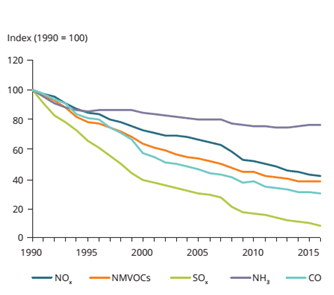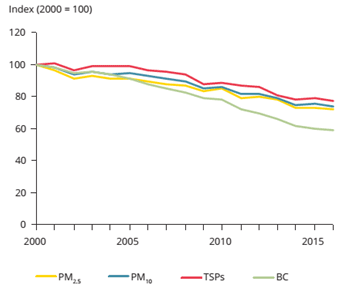



Context - Even if there has been great improvements in air quality and significant decreases of air emissions in the last decades, air pollution is still a problem in Europe.
What is being done to address the issue further and how effective are the measures taken?
Here are the highlights of the 2018 annual European Union (EU) emission inventory report.
This is a faithful summary of the leading report produced in 2018 by the European Environmental Agency (EEA): "European Union emission inventory report 1990-2016 under the UNECE
Convention on Long-range Transboundary Air Pollution
(LRTAP)![]()
At the global level, the Long-range Transboundary Air Pollution (LRTAP) Convention sets emission ceilings and obligations of reporting for a number of pollutants: nitrogen oxides, sulphur oxides, ammonia and organic volatile compounds, heavy metals, persistent organic pollutants, polycyclic hydrocarbons as well as particulate matter. In 2012, the last amendments to the protocols of the Convention have set new targets for emission reductions for 2020.
In the EU, the Gothenburg Protocol (1999) comprising 15 EU Member States set air pollutants emissions commitments for 2010. The Protocol was amended in 2012 to set new emission reduction commitments for 2020.
For nitrogen oxides (NOx), non-methane volatile organic compounds (NMVOCs), sulphur oxides (SOx) and ammonia (NH3), emissions in 2016 were below the Gothenburg Protocol ceilings in all Member States. Three Parties exceeded their NH3 ceilings (Croatia, Germany and Spain), and one Member State (Hungary) exceeded its limit for volatile organic compounds.
These pollutants harm human health and the environment. Certain pollutants also contribute to the formation of ground-level ozone (O3) and secondary particulate matter (PM) in the atmosphere. Some pollutants have indirect and direct effects on the sunlight absorbed by the Earth and reflected back to space (radiative forcing) and hence on the climate.
Since the 1990s, there has been a general downwards trend for emission of all pollutants.
For the main air pollutants, sulphur oxide (SOx) was the pollutant type with the greatest reduction in emissions across the EU. SOx emissions were indeed 91 % less in 2016 than in 1990, followed by carbon monoxide (CO) (-69 %), non-methane volatile organic compounds (NMVOCS) (-62 %), NOx (-58 %) and ammonia (NH33)(-23 %).
Between 1990 and 2016, emissions of the main heavy metals (Pb, Cd, Hg), of chlorinated dioxins and furans, total polycyclic hydrocarbons, HCB and PCBs also dropped by at least 65 %.


| Arsenic (As) : 67 %, | Benzo(a)pyrene : 19 % |
| Chromium (Cr) : 72 %, | Indeno pyrene (IP) : 65 % |
| Nickel (Ni) : 72 %, | Dioxins & furans : 67 % |
| Selenium (Se) : 34 % | HCB : 95 % |
| Zinc (Zn) : 36 %. | PCB : 74 % |
| Total polycyclic aromatic Hydrocarbons (PAHs) : 83 % | Persistent Organic Pollutants (POPs): clear emissions decreases over the last 25 years which remained broadly stable since 2000. |
The reduction in sulphur emissions is the result of a combination of 3 main measures:
Regarding the other main air pollutants emissions, much progress has been made since the early 1990s in reducing point-source emissions of these substances, particularly from industrial facilities. These emissions have been decreasing more slowly over the past decade.
The 'road transport' sector, primarily through legislative measures requiring the abatement of vehicle exhaust emissions, has significantly reduced its emissions since 1990. The road transport sector remains nevertheless a major source of the ground-level ozone precursors NOx, CO and NMVOCs.
Energy- and process-related emissions from industry contribute considerably to the overall emissions of a number of the heavy metals and persistent organic pollutants (POPs). Meanwhile, NOx emissions decreased considerably as a result of certain technical measures, mainly:
This has been achieved partially through improved abatement techniques used in waste water treatment and incinerators and abatement in the metal refining and smelting industries. In some countries, the emissions reduction followed the closure of older industrial facilities due to economic restructuring. Total emissions fell faster between 1990 and 2000 than in the following years.
Since 2000, aggregated emissions of total suspended particulates (TSPs) have fallen by 22 % across the EU (and by 54 % since 1990), mainly thanks to the introduction or improvement of abatement measures across the 'energy production sector', the 'road transport' and the 'industry' sectors, coupled with other developments, such as switching from fuels containing high amounts of sulphur to those with low amounts.
As SOx, NOx and ammonia play an important role in the formation of secondary PM, the reduction of emissions of these pollutants also influenced the reduction in PM formation.
The report contains several recommendations that may further improve the quality of the EU inventory in future. For example, where estimated values are not available, Member States should submit complete inventories and use proper notation keys. They should recalculate emission data for past years when new methods or new scientific knowledge become available.

This summary is free and ad-free, as is all of our content. You can help us remain free and independant as well as to develop new ways to communicate science by becoming a Patron!